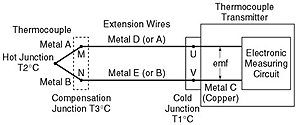| The figure shows use of extension wires between
the thermocouple and a thermocouple transmitter. The extension wires
are made of metals D and E. |
 |
The junctions between metals A and D and between
B and E are M and N in the figure, respectively. M and N, which are
called compensation junctions, should be at the same temperature (T3°C)-
not necessarily constant.
The temperature-emf characteristic of the metals of the extension
wires agrees with that of the thermocouple in the narrow temperature
range of the plant environment. Therefore, the emf at the input of
the thermocouple transmitter corresponds to the temperatures of the
hot and cold junctions, T1 and T2.
There are two types of extension wires. One type uses the same materials
as the thermocouple (Metal D = A, Metal E = B) and the other type
uses different metals from the thermocouple, as discussed above. They
are called the extension type and the compensation type, respectively.
The extension type provides a high accuracy even with wide temperature
changes in the environment, although it is generally more expensive
than the compensation type. For a thermocouple of inexpensive materials,
like Type J and T, thermocouple metals are used for the compensation
wires. The compensation type is low in cost, although its usable temperature
range is narrow. You should choose extension wires to meet your application
requirement. |
| M-System has flexible solutions to meet your specific
application and requirements. Consult our Signal Conditioners Data
Library. |
|
 Why
are extension wires used?
Why
are extension wires used?
 We
use extension wires to reduce the cost of a thermocouple temperature measurement
system without sacrificing the measurement accuracy.
We
use extension wires to reduce the cost of a thermocouple temperature measurement
system without sacrificing the measurement accuracy.